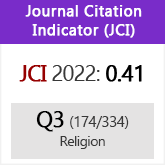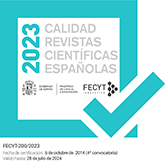Towards a Talmudic Lexicon: The Aramaic Root ק.פ.י / q.f.y in the Light of a Story from the Babylonian Talmud
DOI:
https://doi.org/10.3989/sefarad.016.007Keywords:
Babylonian Talmud, Tractate Eruvin, LexiconAbstract
The tractate Eruvin of the Babylonian Talmud cites three stories, presented as a single concatenated whole, with all three sharing a single feature: they all have recourse to “language of wisdom” as a medium ascribed to each protagonist. The present article focuses on the first story in isolation from the others, placing emphasis on the Aramaic root ק.פ.י / q.f.y as a special case in connection with studying, on the basis of which the Aramaic word ve-titqfey is formed.
Downloads
References
Altschuler, David (1954): Metzudat Zion. Mikraot Gedolot, ed. (Tel Aviv: Pardes).
Brand, Yehoshua (1953): Ceramics in Talmidic Literature (Jerusalem: Mossad Ha'rav Kook). PMCid:PMC1620112
Dalman, Gustav H. (1967): Aramäisch-Neuhebräisches Handwörterbuch zu Targumim, Talmud und Midrasch (Hildesheim: Georg Olms).
Eidelsh, Shmuel (1961): Hidushei Maharsha Commentary to bEruvin (Bene Beraq: Tevel Institution).
Even-Shoshan, Avraham (1993): Ha-Milon HeHadash Otzar Shalem shel HaLashon Ha-'Ivrit (Jerusalem: Kiriat Sefer).
Gaon, Se'adia (1960): Commentary to Pentateuch (Jerusalem: Yossef Hassid).
Gross, Michael, Barkai, Yair and Yossi Melamed (2008): Different Readings of the Aggada (Tel Aviv: Mofet Institution).
Ha-Meiri, Menachem (1990): Hidushei HaMeiri Commentary to bEruvin. S. Z. Broida, ed. (3rd print, Jerusalem: Mossad Ha'rav Kook).
Jastrow, Marcus (1967): A Dictionary of the Targumim, the Talmud Babli, and Yerushalmi, and the Midrashic Literature (Brooklyn: Shalom).
Kimchi, David (1954): Commentary to Chronicles. Mikra'ot Gedolot, ed. (Tel Aviv: Pardes).
Onqelos (1960): Translation to Pentateuch (Jerusalem: Yossef Hassid).
Rabbinovicz, Raphaelo (1960): Dikdukei Sofrim (Jerusalem: Ma'ayan Hahokhmah).
Sabar, Yona (2002): A Jewish Neo-Aramaic Dictionary (Wiesbaden: Harrassowitz).
Sokoloff, Michael (2002): A Dictionary of Jewish Palestinian Aramaic of the Byzantine Period (Ramat-Gan–Baltimore–London: Bar Ilan University Press).
Stein, Dina (2001): "A Maidservant and her Master's Voice: Discourse, Identity, and Eros in Rabbinic Texts," Journal of the History of Sexuality 10:3-4, 390-391. https://doi.org/10.1353/sex.2001.0076
Valler, Shulamit (2003): "Women's Talk – Men's Talk Babylonian Talmud Erubin 53a-54a," Revue des Études Juives 162:3-4, 421-445. https://doi.org/10.2143/REJ.162.3.503633
Valler, Shulamit (2006): "Megamot be'aricha sifrutit shel sugya talmudit, sugyat Eruvin daf 53b-54a-ossef aruch shel sihot hullin," Dafim LeMechkar BeSifrut 14-15, 21.
Valler, Shulamit and Shalom Razabi (2007): Small Talks in the Babylonian Talmud (Tel Aviv: Am Oved).
Yitzhaki, Shlomo, (1961): Commentary to bEruvin (Bene Beraq: Tevel Institution).
Downloads
Published
How to Cite
Issue
Section
License
Copyright (c) 2016 Consejo Superior de Investigaciones Científicas (CSIC)

This work is licensed under a Creative Commons Attribution 4.0 International License.
© CSIC. Manuscripts published in both the printed and online versions of this Journal are the property of Consejo Superior de Investigaciones Científicas, and quoting this source is a requirement for any partial or full reproduction.All contents of this electronic edition, except where otherwise noted, are distributed under a “Creative Commons Attribution 4.0 International” (CC BY 4.0) License. You may read here the basic information and the legal text of the license. The indication of the CC BY 4.0 License must be expressly stated in this way when necessary.
Self-archiving in repositories, personal webpages or similar, of any version other than the published by the Editor, is not allowed.














